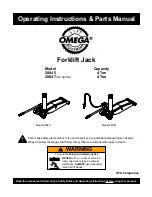
8
SAFETY INSTRUCTIONS….cont
The electric welding arc must not be observed with the naked eye. Always use a
welding mask; Ensure the welding mask is fitted with the correct shade of filter
lens for the welding current level.
Welding gauntlet gloves should be worn to protect the hands from burns, non-
synthetic overalls with buttons at the neck and wrist, or similar clothing should be
worn. Greasy overalls should not be worn. Wear suitable protective footwear.
Always wear correctly rated protective clothing.
Avoid oily or greasy clothing, a spark may ignite them.
Hot metal such as electrode stubs and workpieces should never be handled
without gloves.
First aid facilities and a qualified first aid person should be available for each
shift unless medical facilities are close by for immediate treatment of flash burns
to the eyes and skin.
Flammable hair products should not be used by persons intending to weld.
Warn bystanders not to watch the arc and not to expose themselves to the
welding-arc rays or to hot metal.
Keep children away whilst welding, they may not be aware that looking at an
arc can cause serious eye damage.
Protect other nearby personnel from arc rays and hot sparks with a suitable non-
flammable partition.
ed by radiant or conducted heat.
After the work is done, check that the area is free of sparks, glowing embers and
flames.
An empty container that has held combustibles, or that can produce flamma-
ble or toxic vapours when heated, must never be welded, unless the container
has first been cleaned. Consult HSE INDG214, HSG250 and CS15. HSE docu-
ment CS15 includes information on cleaning by thorough steam or solvent/
caustic cleaning followed by purging and inserting with nitrogen, carbon diox-
ide or water filling just below working level.
A container with unknown contents should be treated as if it contained combus-
tibles (see previous paragraph),
Do not
depend on sense of smell or sight to
determine if it is safe to weld.
Hollow items must be vented before welding as they can explode.
Explosive atmosphere; Never weld when the air may contain flammable dust,
gas or liquid vapours (such as petrol).
GLARE AND BURNS
21
TROUBLESHOOTING
Note:
If none of the above solutions work then contact your local distributor
for repair, or contact SIP technical for more advise.
ARC
Symptom
Possible Cause
Solution
Alarm light on.
Overheated.
Allow the to cool .
Difficult to strike an arc.
Damp electrode.
Incorrect electrode.
Warm the electrode or re-
place.
Select the correct size elec-
trode to match the amperage
set on the machine.
Burns through thin metal.
Material too thin for
arc welding.
Use the TIG function.
TIG
Symptom
Possible Cause
Solution
Quality of weld is poor.
No gas flow.
Incorrect ceramic
nozzle.
Check condition of
tungsten.
Check gas flow and adjust as
required.
Select correct ceramic nozzle
to match tungsten.
Re-grind to shape or replace.
Overheating.
Fan problem.
Rear casing blocked,
obstructing air flow.
Poor connection on
earth clamp/
electrode holder.
Tungsten does not
match collet/collet
body.
Check fan connections, re-
place fan.
Check and clean.
Check and clean all connec-
tions.
Change collet/collet body to
match tungsten.
Difficult to strike an arc.
Tungsten in poor
condition
Re-grind to shape or replace.
Alarm light on.
Overheated.
Allow the to cool.
































